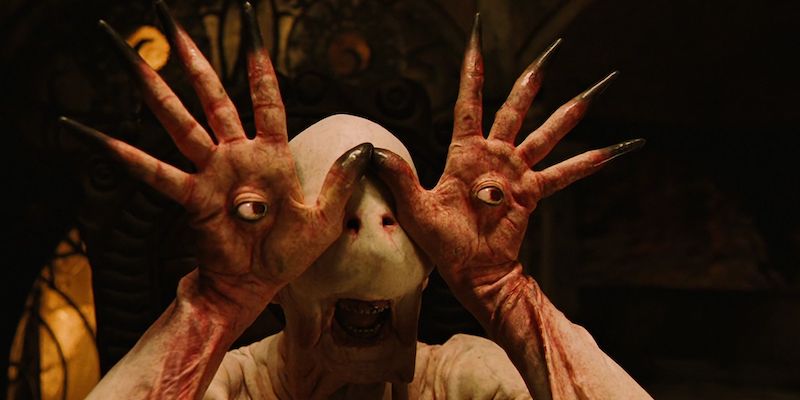Pans Labyrinth's Pale Man

The pale man scene is an iconic scene for the horror genre. The scene is full of symbolism, art references, beautiful use of cinematography, traditional use of the horror genre conventions such as sound, and finally it represents the key theme: Disobedience.
Ultimately this is the most ambiguous scene in terms of meaning. The audience questions who the pale man is, who he represents and whether or not he belongs to the underworld or is part of something else. From the very beginning of the scene, when Ofelia remains in the cool-toned real world, the rules are made explicitly clear: "Don't eat or drink anything during your stay". As soon as Ofelia's chalk door opens, the sinister orchestra music plays as the camera zooms out through a long corridor, adhering to the genre conventions of horror. The shot is symmetrical and utilises the rule of thirds. Although we are in the underworld and there lighting is warm-toned, it's still not inviting or cosy.
The first significant piece of mise-en-scene in the scene is the hour glass. This is tied to Vidal's watch which is also seen as an important piece of iconography in the film. Yet unlike Vidal's watch which is complicated and contains lot's of clogs working together, an hour glass is much more simple yet provides the same outcome. This can be applied to the complicated facist regime in contrast to the simple underworld with rules and consequences.
The framing of this scene is also an essential and explicit way in which this scene is tied to Captain Vidal. The framing has has echoes of the dinner scene where Vidal is framed at the head of a long dinner table overlooking a feast with a roaring fireplace behind him. Perhaps- under the assumption that the underworld is a figment of Ofelia's mind- this is how she depicts Captain Vidal as a monster in her world.
The camera pans from right to left across a series of paintings on the walls which refers to the painting "Satan Devouring His Son" by Goya. It contains the Pale Man devouring his children. One may infer the Pale Man is the underworld's version of Satan in this context.
However, another explicit link to Vidal and Fascism through the mise-en-scene is the pile of shoes referencing Auschwitz and the Holocaust.
Finally, it wouldn't be true to the horror conventions is there was an uncertainty surround our characters escape towards the end and Del Toro effectively builds tension this was and the scene ends with Ofelia's climactic getaway.
Comments
Post a Comment